Last Updated on February 9, 2024 by Kittredge Cherry
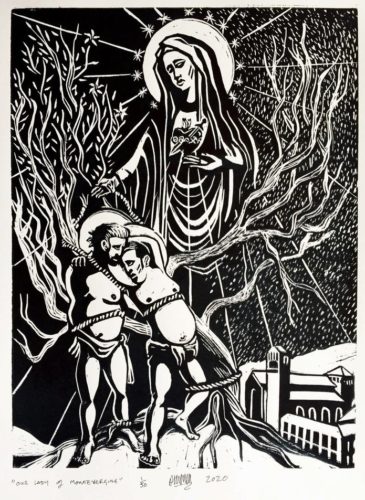
The Madonna of Montevergine has a reputation for helping queer people since medieval times — including the miraculous rescue of a male couple left to die in Italy more than 750 years ago. Processions to her shrine have been called “ancestral gay pride” marches and Italian LGBTQ activists have adopted her as an unofficial patron saint. Interest in her as a patron of LGBTQ people is growing by leaps and bounds.
The miracle at Montevergine may be the only recorded miracle in church history in which the Madonna saves a pair of same-sex lovers from homophobic violence. LGBTQ religion scholars and people of faith search long and hard for queer people buried in church history, so it is exciting to find a little-known but long-standing legend that the Madonna rescued a same-sex couple in the year 1256.
The pontifical coronation of her traditional icon has been described as “the first church-wide LGBTQ+ celebration.” Artists continue to make new queer icons showing the Montevergine miracle.
Montevergine’s biggest and queerest procession happens every year on Candlemas (Feb. 2), a feast that celebrates the presentation of the baby Jesus in the Temple and the ritual “purification” of his mother, Mary. Traditional Candlemas celebrations involve a candlelit procession to the church, where candles are blessed for use at church and in the homes of the faithful. Among Montevergine’s Candlemas pilgrims are genderbending devotees of Mary, known as “femminielli,” a traditional queer or third-gender people who are just beginning to get attention from scholars in English. The abbey of Montevergine is also important because the shroud of Turin was hidden there for safe-keeping during World War II
Candlemas falls 40 days after Christmas and is rooted in the pagan spring festival of Imbolc, which is celebrated on Feb.1-2. Brigid of Kildare, another LGBTQ-related saint, traces her Feb. 1 feast day to Imbolc too. Her sacred flames are echoed in the candles of Candlemas In many countries Candlemas festivities focus on Mary and the sacred feminine.
New in 2024:
Q Spirit is introducing a new icon of the Montevergine Madonna for Candlemas 2024. Not only is the rescued couple queer, but Mary may also be nonbinary in “Madonna of Montevergine” by the artist known as Faithful Heretic. The icon mixes Christian and LGBTQ symbols in a fascinating fusion. Raised Mormon, Faithful Heretic is an Episcopalian lay minister and a lifelong student of history, especially medieval history and LGBTQ history.
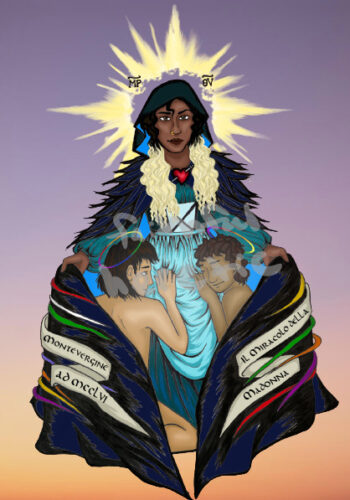
“Madonna of Montevergine” by Faithful Heretic Icons, 2023
“The young couple have halos in a Pride rainbow spectrum, representing their marginalized gender and sexuality. Traditionally, the couple is said to be two young men, but I made them deliberately androgynous in this icon,” the Faithful Heretic website explains.
The black Madonna’s cloak is adorned with Candlemas processional ribbons in colors of the rainbow and the Italian flag. Her crimped, bleached-blonde hairstyle was worn by ancient transfeminine priestesses on the Montevergine site in pre-Christian times. The letters above her head are an abbreviation of the Greek phrase “Mater Theos,” meaning “Mother of God.” Echoing the Our Lady of Sorrows devotional image, she wears a heart-shaped brooch pierced by a sword to express her pain and compassion for those who are wounded. Her halo shines like the sunlight that melted the ice in the miraculous queer rescue.
Madonna miraculously rescues a same-sex couple in 1256
Here is the legend of Montevergine’s miracle: Two young men, usually described in English as “homosexuals” or “gay men,” were madly in love. They tried to keep their relationship secret, but it was impossible. On a cold and gloomy winter day in 1256, they were spotted holding hands and kissing on the way to worship.
Enraged by their queer love, an angry crowd stripped them naked and beat them. The mob then drove the same-sex lovers up into the woods on Mount Partenio, where the shrine to the Virgin of Montevergine is located. They tied the pair to a barren tree. Some accounts say they were imprisoned there by slabs of ice. Then they left the couple there overnight to die from exposure to the cold or be eaten by wolves.
The Madonna of Montevergine was moved by the men’s love for each other. She sent unexpected sunshine to warm the lovers, melt the ice and miraculously set them free. Some accounts say that the couple celebrated by having gay sex on the spot! Because of this divine miracle, the community had to accept same-sex love and allow the men to live openly as a couple. Through supernatural power, the community was transformed into a place of tolerance toward sexual minorities. This legend shows why the Madonna of Montevergine is known as “She who gives everything and forgives everything.”
While the legend is widely known today, its justification appears to be oral tradition — specifically a 20th-century oral narrative — rather than historical documents, according to an Italian source.
Queer miracle of Montevergine shown by British artist
With bold black-and-white strokes, “Our Lady of Montevergine” by queer British artist Tony O’Connell shows the Virgin Mary in solidarity with the queer couple that she rescues. The icon appears at the top of this post. He completed the limited-run linocut in September 2020. Prints are available at his HallowedPrints Etsy shop.
In the snowy corner on the lower right sits the real church as it looks in Montevergine. The two lovers express their connection to each other with their posture. They are tied to a barren tree that fills the frame and bursts into blossom at Mary’s touch. She herself is wounded: The double scar on her cheek matches the marks left on the famous Black Madonna of Czestochowa when thieves pried jewels off her cheek.
O’Connell explained the symbolism of his artwork in a statement for Q Spirit:
“In the story of Her appearance the lovers had been attacked by the locals by being stripped and beaten, which has been a motif of violence and humiliation often used in images from Sebastian to the Crucifixion to the modern explosion of violence against LGBT (particularly black trans women). Having been beaten it occurred to me that one of the figures would have the same facial lacerations. The Divine manifesting at the point where we need it most is like perfect compassion taking actual form; so it seemed that in Her compassion for the two lads She could be seen to have mirrored and taken on their pain and injury. Almost like a reverse stigmata, where the injuries of their violation were evident on her face because of Her solidarity with them.
Further on this theme I chose the sword piercing the heart from the prophecy of Simeon about her sorrow of the killing of her own beloved son. I also chose to picture her appearing alone like the image of Lourdes or Fatima, rather than holding the infant Christ. This was to suggest her maternal divinity extending to all suffering beings — exemplified by these young men at this point. I imagined her heart pierced for them as well as for Jesus. In my notes I was reminded of Jesus commending John to his mother and Her to him from the cross as a way of explaining her universal motherness for all.”
His breathtakingly fresh Montevergine image draws on both Christian and Buddhist iconography. Raised in the Roman Catholic tradition, O’Connell has been a practicing Buddhist since 1995. He told Q Spirit that he had Buddha in mind when he made the moon into a halo for the Virgin. “The full moon is an important symbol in Buddhism, representing the unobstructed mind and a signifier of enlightenment. The Buddha’s own halo on the night he attained enlightenment is often represented as the full moon rising behind Him,” O’Connell explained.
He also sees a connection between Our Lady of Montevergine and the Buddhist spirit of compassion known as Tara, Kuan Yin or Avalokiteshvara. “In my own tradition the divine feminine is most often represented by Tara — which of course (like Buddha or Christ) is not a name but a title — meaning in this case “rescuer” or “savior.” There is a set of praises to 21 different Taras… My favourite line to describe Tara from the 21 Praises is ‘Whose face is like a thousand full moons in autumn,’ to describe Her brilliance,” he said.
Queer miracle of Montevergine shown on Italian website
An anonymous artist created “Miracle of Montevergine of 1256” and an LGBTQ-positive website devoted to it: montevergine1256.com. The bilingual English-Italian website is loaded with background information related to “the miracle of the boys in love.”
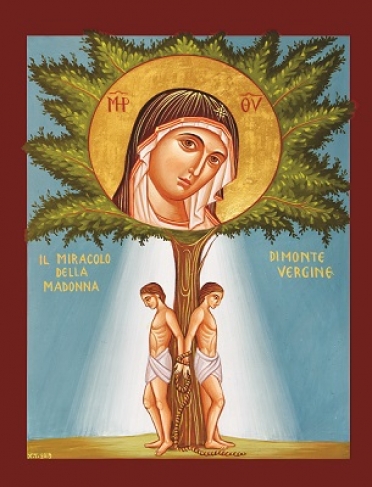
“Miracle of Montevergine of 1256” icon by Montevergine1256.com
Montevergine1256.com proclaims with pride and faith that the Madonna of Montevergine “saved a couple of gay boys in love who were condemned to death in 1256,” making Montevergine into “the only LGBTIQ pilgrimage in the world” and a place where “most of the LGBTIQ pilgrims are very devoted to Our Lady.” A detailed description of the symbolism in the icon points out that “the tree vaguely recalls that of another icon much loved by the LGBT + community, the icon of the martyrdom of Saint Sebastian tied to the tree pierced by arrows.”
Black Madonna of Montevergine called “Slave Mama”
The Virgin of Montevergine is often considered a black Madonna, even though her face may not look very dark in photos. Some devotees fondly call her “Mamma Schiavana,” which can mean “Slave Mama” or “Slavic Mama.”
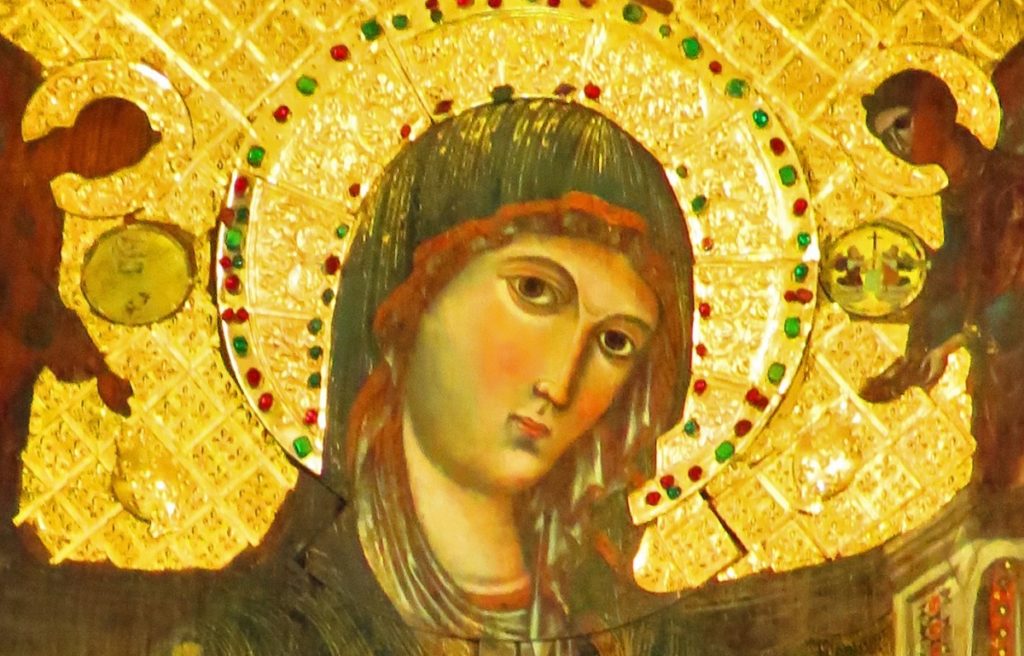
Detail from “Madonna of Montevergine” photo by Gianfranco Vitolo
She gets her nickname “Slave Mama” both because many people consider her to be a Black Madonna and because she welcomes even the most marginalized, persecuted people in society, including queers and enslaved people. Black Madonnas are said to embody the shadow side of the divine, the unconscious and unpredictable aspects that are usually buried or kept in darkness. Various meanings behind this name are explored in “Black Madonnas: Feminism, Religion and Politics in Italy” by historian Lucia Birnbaum. The book includes specific discussion of the Madonna of Montevergine. The 2019 book “Healing Journeys with the Black Madonna: Chants, Music, and Sacred Practices of the Great Goddess” by Alessandra Belloni (with a foreword by Matthew Fox) has a chapter on the Madonna of Montevergine, including her historic role as patron saint of LGBTQ people. The book is an experiential guide to the ancient healing rituals of the Black Madonna, with access to 12 audio tracks.
 Additional evidence for the centuries of queer devotion at Montevergine is found in the records of a fire there in 1629. A letter to Pope Francis written on behalf of the LGBTQ community by Vladimir Luxuria, Italy’s first transsexual parliamentarian, explains, “On the morning after the tragedy, the Benedictine monks found in the Monastery hospice the lifeless bodies of several men in women’s clothing.” Such people are known as “femminielli,” an Italian word that defies translation.
Additional evidence for the centuries of queer devotion at Montevergine is found in the records of a fire there in 1629. A letter to Pope Francis written on behalf of the LGBTQ community by Vladimir Luxuria, Italy’s first transsexual parliamentarian, explains, “On the morning after the tragedy, the Benedictine monks found in the Monastery hospice the lifeless bodies of several men in women’s clothing.” Such people are known as “femminielli,” an Italian word that defies translation.
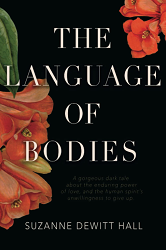 Mamma Schiavona plays an important role in the 2022 LGBTQ thriller The Language of Bodies” by Suzanne DeWitt Hall. Readers will wonder if the Madonna of Montevergine still intervenes to help queer couples as the main character struggles with her desire for revenge against the homophobic man who murdered her wife, a transgender woman of color. Inspired by real events, the novel explores the psychology of gender identity, sexuality, and toxic Bible-based bias with authenticity.
Mamma Schiavona plays an important role in the 2022 LGBTQ thriller The Language of Bodies” by Suzanne DeWitt Hall. Readers will wonder if the Madonna of Montevergine still intervenes to help queer couples as the main character struggles with her desire for revenge against the homophobic man who murdered her wife, a transgender woman of color. Inspired by real events, the novel explores the psychology of gender identity, sexuality, and toxic Bible-based bias with authenticity.
Queer devotees join in “Ascent of the Femminielli”
LGBTQ and third-gender people mix with the rest of the population in the Candlemas procession to the Madonna of Montevergine’s mountain shrine. The Benedictine Abbey of Montevergine is located in southern Italy about 30 miles east of Naples. The closest city is Mercogliano (population 12,000). The town of Ospedaletto d’Alpinolo (population 1,934) is even closer.
The line between sacred and profane blurs during hours of singing and dancing accompanied by traditional large tambourines. Oxen and horses pull floats up the mountain with the sometimes raucous pilgrims. The boisterous flavor of these celebrations can be sensed from photos and videos.
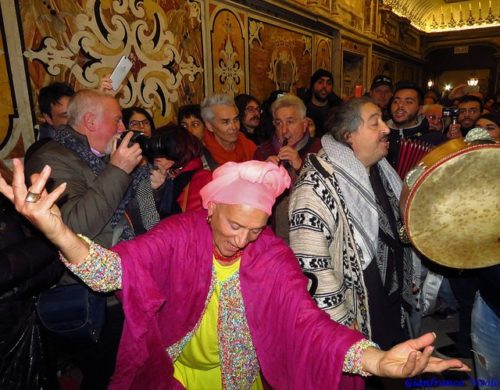
Devotees dance at Montevergine during the “Ascent of the Femminielli” on Candlemas 2017. Note the large tambourine. (photo by Gianfranco Vitolo)
The processions are called “juta dei femminielli” in Italian, meaning “ascent of the femminielli.” English speakers tend to translate “femminielli” as gay, homosexual, transgender or transsexual, but they existed for centuries before any of those terms were coined. These traditional figures disrupt the standard male-female binary. A helpful definition comes from Wikipedia: “Femminielli is a term used to refer to a population of homosexual males with markedly feminine gender expression in traditional Neapolitan culture.”
Femminielli are accepted in Neapolitan society, while some resistance to LGBTQ rights remains. They are considered lucky and almost sacred. People ask them to bless their babies and interpret their dreams. Tradition calls for pairs of femminielli to unite in a marriage-like ritual outside a church. They are different from today’s out and proud LGBTQ people, and their subculture is in danger of extinction. But the presence of the femminielli confirms that for centuries queer people have existed — and even found acceptance in some places.
 The 2017 book “Talking Bodies: Interdisciplinary Perspectives on Embodiment, Gender and Identity” offers this explanation: “The Neapolitan femminielli, traditional figures of men ‘impersonating’ women, can be seen as important precursors not only for today’s trans women, but also for individuals embodying the idea of a third gender.”
The 2017 book “Talking Bodies: Interdisciplinary Perspectives on Embodiment, Gender and Identity” offers this explanation: “The Neapolitan femminielli, traditional figures of men ‘impersonating’ women, can be seen as important precursors not only for today’s trans women, but also for individuals embodying the idea of a third gender.”
Some tensions arise between the free-flowing folk Christianity and the institutional church, but it is significant that church festivals mostly welcome the femminielli. The tensions This supports the theory that queer people have a unique spiritual role in the evolution of human consciousness because they cross the boundary between male and female.
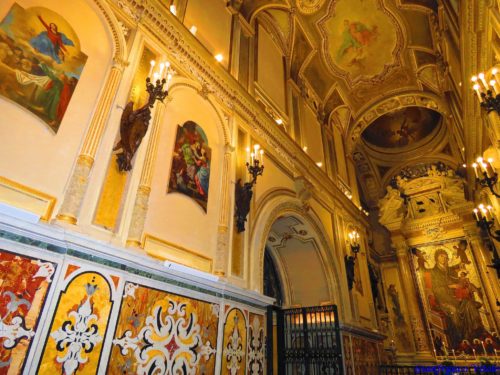
The Madonna of Montevergine overlooks a sanctuary full of radiant art (photo by Gianfranco Vitolo)
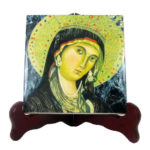
Our Lady of Montevergine icons are available on Etsy
The Candlemas festival launches a season of pilgrimage that lasts until the closing festival on Sept. 12, the feast of the Holy Name of Mary. Montevergine is off the beaten path for international tourists, but is a popular destination for Italians and receives 2 million visitors per year. May 22 is the feast day for the Madonna of Montevergine.
The byzantine icon in Montevergine depicts the Virgin Mary on a throne with the baby Jesus on her lap. It measures 12 feet high and six feet wide. The icon is the focal point of an ornate sanctuary loaded with colorful treasures of religious art.
As with many Black Madonnas, it is said to be painted by Saint Luke in Jerusalem. Reproductions of her icon are rare and hard to find, but the Madonna of Montevergine is available on ceramic tiles at Etsy. Vintage souvenir medals from Montevergine are also available on Etsy.
LGBTQ rights and the Madonna of Montevergine
Femminielli don’t necessarily identify as gay or trans, but LGBTQ political activists have begun to embrace them. Significant LGBTQ participation in the Montevergine Candlemas festival began after a dispute in 2002 when the former abbot of Montevergine expressed disapproval of the femminielli and their loud prayers.
LGBTQ activists have made progress in nearby Ospedaletto d’Alpinolo. The town is home to Italy’s first gender-neutral bathroom, which opened there during Candlemas 2017. The proud mayor called it, “two square meters of civilization.” In addition, the town gave honorary citizenship to a gay couple who were finally allowed to marry legally after 53 years of love. A new sign was posted at the town entrance proclaiming, “Ospedaletto d’Alpinolo is against homotransphobia and gender violence.”
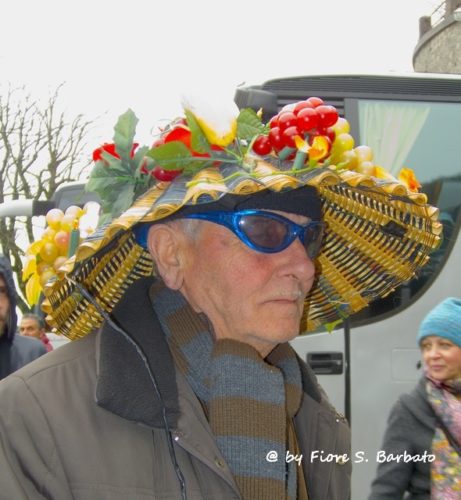
“Montevergine Candlemas 2014” by Fiore Silvestro Barbato
The Abbey of Montevergine made headlines 2017 by donating an innovative Nativity scene to the Vatican. Critics attacked it for being homoerotic, sexually suggestive and a “lobbying tool for homosexual rights” because it included a near-nude man reclining to illustrate God’s call to “clothe the naked.” The controversial Nativity scene also featured a reproduction of the Our Lady of Montevergine icon.
Montevergine was queer in pre-Christian times
The queer history of the Montevergine site dates back to pre-Christian times. Like many churches with Black Madonnas, Montevergine was originally dedicated to Cybele. A temple to the pagan mother goddess Cybele was located on the mountain before it became home the Madonna of Montevergine.
In the pagan era men castrated themselves at Montevergine as a gift to the goddess and an act of rebirth. Through the castration ritual they became Corybantes, also known as Galli: defined variously as transfeminine priestesses or eunuch priests who dressed as women. They were known for their ecstatic, even orgiastic processions with dancing and drumming.
The first church was consecrated at Montevergine in 1124 — about 100 years before the Madonna’s miraculous rescue of the male couple. Mary’s devotees at Montevergine incorporated some of the pagan spirit into their Christian worship through a kind of blessed syncretism. A drawing of the Corybantian dance from “A Dictionary of Greek and Roman Antiquities” shows the eunuch priests of Cybele dancing in a nude procession with large tambourines like the ones played at Montevergine festivals now.

Corybantian dance as pictured in “A Dictionary of Greek and Roman Antiquities” by William Smith, 1870 (Wikimedia Commons)
The Montevergine monastery contains treasured relics that are said to be the bones of three Biblical eunuchs: Shadrach, Meshach and Abednego. According to the Hebrew scriptures, they were saved from a fiery furnace with the prophet Daniel by a mysterious figure “like the Son of God.” Many LGBTQ Christians identify with these and other eunuchs as queer people outside the male-female gender system.
New research on femminielli in English
Most material about femminielli is only available in Italian, but new research is starting to be published in English. A rare 18th-century painting of a femminiello was recently discovered and purchased in 2014 by the Portland Art Museum in Oregon. And two 2017 books include sections on femminielli.
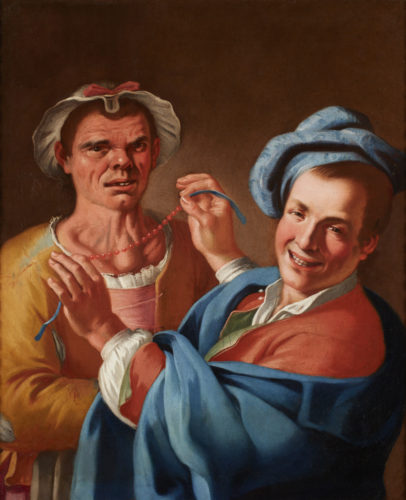
“Il Femminiello” by Giuseppe Bonito (Portland Museum of Art)
“Il Femminiello” was painted by Giuseppe Bonito between 1740 and 1760. A pretty young man in blue playfully tries to put a red coral necklace on the older femminiello as both gaze at the viewer. The nature of their interaction remains open to interpretation.
“Images of real people crossdressing are extremely rare in the history of European art,” Portland Art Museum curator Dawson Carr explains in a video about the painting. “This was, of course, because of widespread and enduring prejudice against gender nonconformity virtually throughout the continent and of course it was passed on to us. This painting exists only because of a very special situation: a little pocket of acceptance of a local community of male-to-female crossdressers known as femminielli.”
Carr describes the painting as “an incredibly important document for the history of transgender subjects in western art history.”
Femminielli are discussed in two books published in 2017:
“Talking Bodies: Interdisciplinary Perspectives on Embodiment, Gender and Identity,” edited by Emma Rees. Femminielli and the Madonna of Montevergine are covered in a chapter by Marzia Mauriello.
“Genderqueer and Non-Binary Genders,” edited by Christina Richards, Walter Pierre Bouman and Meg-John Barker. A short section on femminielli is included.
“We entrust our prayer to ‘the Mother of Everyone’”
Themes of queer identity and Christian faith from Montevergine are summed up in the letter that Luxuria wrote on behalf of the LGBT community. The letter was publicly presented at Montevergine’s Candlemas pilgrimage in 2014. Here is a translated excerpt:
“Every year on Feb. 2, on the occasion of the celebrations of Candlemas, the Catholic community and homosexual and transsexual people of Campania and beyond go to the Shrine of Montevergine to entrust their prayers to Our Lady, the Slave Mamma, respecting the sacredness of the place that houses her, but without renouncing those forms of popular devotion which offer supplication to Our Lady in songs, accompanied by the rhythm of large tambourines played by the faithful.
The community of faithful has always expressed its desire not to feel excluded by the Catholic community, without its gender identity or sexual orientation being considered a spiritual obstacle, a denial of the right to faith that should be guaranteed to all…. We entrust our prayer to Our Lady the Slave, ‘the mother of everyone.’”
Madonna of Montevergine prayers
Q Spirit’s Litany of Queer Saints includes this line:
“Our Lady of Montevergine, patron of queer people since medieval times, pray for us now and at the hour of our death.”
Links related to the Madonna of Montevergine as LGBTQ patron
The Madonna di Montevergine, mother of LGBTQ Catholics by Emma Cieslik (uscatholic.org, Nov. 9, 2023)
Patron of LGBTQIA: Our Lady of Montevergine (video by Open Table Metropolitan Community Church in Manila, Philippines)
Links related to Mary as a queer liberator
Traditional Italian Madonna Devotion Attracts Third Gender “Femminielli” (New Ways Ministry)
Mary, Diana and Artemis: Feast of Assumption has lesbian goddess roots
Black Madonna of Czestochowa becomes lesbian defender Erzuli Dantor
Queer Lady of Guadalupe: Artists re-imagine an icon
“Mary, Queer Liberator” prayer: We your queer children call on you
Advent: Lesbian Mary’s virgin birth
Support Polish LGBTQ activist arrested for rainbow Virgin Mary posters
___
To read this article in Spanish, go to:
Madonna de Montevergine: Patrona de las personas LGBTIQ+ desde la época medieval (Santos Queer)
___
Rainbow Christ Prayer in Italian: La Preghiera del Cristo Arcobaleno
___
Top image credit:
“Our Lady of Montevergine” by Tony O’Connell. Limited-run linocut prints are available at his HallowedPrints Etsy shop.
___
This post is part of the LGBTQ Saints series by Kittredge Cherry. Traditional and alternative saints, people in the Bible, LGBT and queer martyrs, authors, theologians, religious leaders, artists, deities and other figures of special interest to lesbian, gay, bisexual and transgender and queer (LGBTQ) people and our allies are covered.
This article was originally published on Q Spirit in February 2018, was expanded with new material over time, and was most recently updated on Feb. 9, 2024.
Copyright © Kittredge Cherry. All rights reserved.
Qspirit.net presents the Jesus in Love Blog on LGBTQ spirituality.

Our Lady of Montevergine icons are available on ceramic tiles from Etsy







thank you so much for this article. Mercogliano is my ancestral home and this history has never been shared with me, despite being out to my family. my nonna venerated la Madonna nera and my family visits the monastery often and this connected a lot of dots for me in a very healing way.
I’m a musicologist, and I recently heard a Napolitana colleague give a paper about ‘a ffigliuola music which is a style of folk music typical in the area which venerates seven Madonnas, of which La Nera is the seventh. I wonder if you can hear this type of music at the pilgrimages and definitely want to go as soon as I can.
Thank you for this! I would much love to visit this shrine at Candlemas.
This article is also very beautiful: https://roadsandkingdoms.com/2015/femminiello-pride/
Hello! I had the opportunity to visit Montevergine this year in October. It is a beautiful shrine and the icon is more beautiful than you can imagine. I went there on a Saturday and there many Italian pilgrims and Masses were being celebrated every hour on the hour. The best time to visit the chapel is 10-15 minutes before Mass when it’s not as packed.
Concerning the legend of 1256 AD, I would be curious to know when the incident of the 2 “boys” was first mentioned. Outside of February 2, the feast of Candlemas, there are no signs that this shrine is LGBTQ friendly. I’m not saying it’s hostile, but there’s nothing prominent to say this is a place of LGBTQ interest.
Nonetheless, I am grateful for the opportunity to visit and hope to visit again.
An update: I am designing/preaching a “Mamma Schiavona/Montevergine”-themed Eucharist at my parish on 4 February 2024! [St Michael’s Episcopal, Carmichael CA]
This web page will be one I cite. Thanks KC!
I’m delighted that you are designing/preaching a Eucharist honoring the Madonna of Montevergine/ Mamma Schiavona. I’d love to hear more details. She is getting more attention lately, but most people have still never heard of her or her inspiring legend. Thanks for citing my article here at Q Spirit. Best wishes for your event on Feb. 4!
This event that supposedly happened in 1256 is classified as folklore (not history), and the various accounts – which differ from one to the next – describe the two people as “boys” rather than “men”.
This is a most compelling and well-written history of the Abbey at Montevergine and “Mamma Schiavo.” Unless I am mistaken, the fire at the abbey was actually in 1611, not 1629. An account was recorded by Carlo Pinto that year, printed under the title Dello Spaventole e miserabile avenimento del fuoco acceso in Monte Vergine nel Regno di Napoli. [Naples: Appresso Gio. Iacomo Carlino, M. DC. XI.] In the 16-page pamphlet, the fire is actually blamed on the victims—men dressed as women and women dressed as men: …in alcuni morti giovani, che erano d’habito feminile, & in alcune giovanette del maschile vestimento ammantate… The conflagration was reportedly started by “celestial fire,” sent as a vendetta. The printed account is very rare, and is adorned with a marvelous woodcut of the Black Madonna.
How wonderful! Thank you for publishing this article on the Madonna of Montevergine and her protection of and gay and trans/gender non-conforming people. If you live in New York city, visit the statue of the Madonna of Montervergine at the Pontifical Shrine of Our Lady of Mt. Carmel in el Barrio (east Harlem, 115th and 1st Avenue.)
This Thursday, July 16th, is the Feast of Our Lady of Mt. Carmel, one of the largest and longest-standing festas in NYC. New York’s Italian immigrant community built the church at great cost and sacrifice, to escape having to attend Mass in the basements of other Catholic churches, where the Irish church hierarchy had consigned them. It is the subject of a wonderful book by Robert Orsi, The Madonna of 115th Street, a beautiful blend of religious history, immigrant history, and cult feminism. The parish now has many Latino and Haitian members and EVERYONE comes to the festa on July 16th, and the side shrine which contains the enthroned statue of the Madonna of Montevergine is thronged with petitioners all day.
One year, I took an old holy medal of the Montevergine Madonna which hung from a ribbon to the church on the festa to bless it. There was a Haitian woman, very likely a practitioner or priestess of voudon, praying intensely before the statue and it was very clear when I looked in the Madonna’s eyes that the medal belonged to this devotee. I gave it to her immediately. The festa is a very special time and place, if you can GO!
I appreciate your comment and personal story about the Montevergine Madonna here in the USA.
Does this celebration still occur on July 16? I’m very devoted to our Lady of Mt Carmel.
I have always seen her as the queer mother
One I love despite racial identity
An ancestor who defied the norm and stood different!
Holy Mary mother and model of all odds. Pray for me that I may be worthy of promises of Christ.
Fascinating! Thanks for this.
Wonderful piece. Thank you for promoting this comforting tradition.
May is the month of Mary. On each day of the month Mary is remembered under a particular title. On the 22nd May the Madonna of Montevergine is remembered.
Again, many thanks.
Thanks for alerting me to her feast day. I want to highlight this article every year on an appropriate day. I’m debating whether to go with her feast day (May 22) or Candlemas (Feb. 2), when her biggest, queerest procession happens. May 22 is also Harvey Milk Day here in California!
May 22 is an extra memorial. It doesn’t replace what you’ve already written. So stay with the feast days already written as these are the ones associated with the shrine proper. X
Good point. When I looked up May 22 as her feast day, I discovered there is a church in Seattle (!) dedicated to her, but I didn’t see anything about welcoming LGBTQ people there. It would be interesting to visit though.